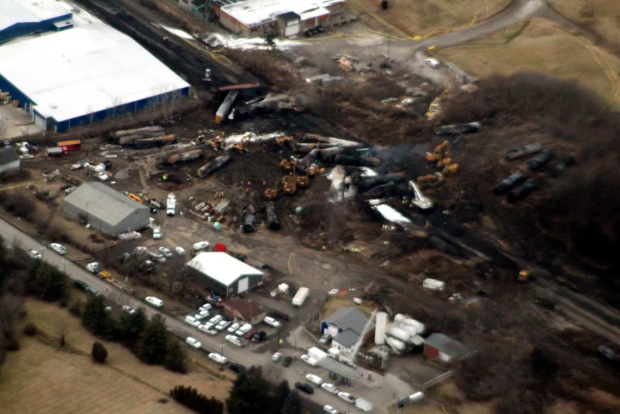Investigation Into Persistent Toxic Chemicals Following Ohio Train Derailment

Table of Contents
Identification of Persistent Toxic Chemicals Released
The Ohio train derailment involved the release of several hazardous materials, many classified as persistent toxic chemicals (PTCs). These chemicals persist in the environment for extended periods, posing significant risks to human health and the ecosystem. Key PTCs identified include vinyl chloride, butyl acrylate, and ethylhexyl acrylate.
- Vinyl Chloride: Known to be a carcinogen, vinyl chloride can cause liver damage, respiratory problems, and central nervous system disorders. It's highly volatile and can quickly spread through air and water.
- Butyl Acrylate: This chemical is an irritant to the eyes, skin, and respiratory tract. Exposure can cause headaches, nausea, and vomiting. It can also persist in soil and water for considerable periods.
- Ethylhexyl Acrylate: Similar to butyl acrylate, this chemical is also an irritant and can cause respiratory issues. Its persistence in the environment and potential for bioaccumulation remain significant concerns.
These persistent toxic chemicals can remain in the environment for years, leaching into soil and groundwater, contaminating water sources, and entering the food chain through bioaccumulation. . .
Immediate and Short-Term Health Impacts
Following the derailment, residents of East Palestine and surrounding areas reported a range of health issues, potentially linked to the released persistent toxic chemicals. These include:
- Respiratory problems: Coughing, shortness of breath, wheezing
- Headaches and dizziness
- Nausea and vomiting
- Eye and skin irritation
. .
While definitively linking specific health issues to chemical exposure requires rigorous epidemiological studies, the correlation between the derailment and these reported health concerns is undeniable. Ongoing health monitoring is critical to assess the long-term impacts on the affected population. The challenges lie in the complexity of establishing a direct causal link given the multitude of factors impacting human health.
Environmental Contamination and Long-Term Ecological Effects
The extent of environmental contamination from the released persistent toxic chemicals is still being assessed, but initial findings indicate significant soil, water, and air pollution.
- Soil Contamination: The released chemicals have likely permeated the soil, affecting plant growth and potentially contaminating groundwater.
- Water Contamination: Nearby waterways are at risk of contamination, impacting aquatic life and potentially drinking water supplies. This requires extensive water quality testing and monitoring.
- Air Contamination: Initial air quality testing revealed elevated levels of harmful chemicals, though the long-term effects on air quality remain to be seen.
These persistent toxic chemicals pose a significant threat to wildlife and plant life. Bioaccumulation in the food chain is a major concern, with potential for long-term impacts on the entire ecosystem. Groundwater contamination could have devastating and long-lasting consequences for the region’s water resources.
Ongoing Investigations and Cleanup Efforts
Several government agencies, including the Environmental Protection Agency (EPA) and the National Transportation Safety Board (NTSB), are conducting investigations into the derailment and its consequences.
- Cleanup Efforts: The cleanup involves removing contaminated soil and water, and utilizing various remediation techniques to neutralize or remove the persistent toxic chemicals.
- Investigative Challenges: The complexity of the situation and the variety of chemicals involved present significant challenges in the cleanup and remediation process.
- Legal Actions: Lawsuits have been filed against the railway company and other involved parties, highlighting the potential for significant legal consequences.
The effectiveness and thoroughness of the cleanup efforts are paramount in mitigating the long-term environmental and health risks associated with these persistent toxic chemicals.
Long-Term Monitoring and Risk Assessment
Long-term monitoring of persistent toxic chemical levels in the environment and human populations is absolutely crucial. This necessitates a comprehensive strategy including:
- Regular testing of soil, water, and air samples.
- Continuous health monitoring of the affected population.
- Development of robust risk assessment models to predict and mitigate future risks.
Transparency and public access to data are vital to ensure public trust and effective risk management. A comprehensive risk assessment plan, coupled with stringent monitoring protocols, is essential for protecting the health of the community and safeguarding the environment.
Conclusion
The Ohio train derailment has highlighted the devastating consequences of accidental releases of persistent toxic chemicals. Comprehensive investigations, thorough cleanup efforts, and robust long-term monitoring are crucial to mitigate the immediate and long-term health and environmental impacts. Understanding the nature of these persistent toxic chemicals and their effects is paramount. Continued vigilance and pressure on regulatory agencies are necessary to ensure accountability and prevent future disasters involving the transport and handling of hazardous materials. Demand transparency and participate in community discussions regarding the ongoing investigation into persistent toxic chemicals following the Ohio train derailment. Stay informed and advocate for responsible environmental protection.

Featured Posts
-
 Grand Slam Highlights Jamaica Observers Top Moments
May 12, 2025
Grand Slam Highlights Jamaica Observers Top Moments
May 12, 2025 -
 Adam Sandlers Massive Net Worth Proof That Comedy Pays Big
May 12, 2025
Adam Sandlers Massive Net Worth Proof That Comedy Pays Big
May 12, 2025 -
 Major League Baseball Suspends Jurickson Profar For 80 Games Due To Ped Use
May 12, 2025
Major League Baseball Suspends Jurickson Profar For 80 Games Due To Ped Use
May 12, 2025 -
 Uruguay Envia Tres Toros A China Como Obsequio A Xi Jinping
May 12, 2025
Uruguay Envia Tres Toros A China Como Obsequio A Xi Jinping
May 12, 2025 -
 How A Childhood Tie Shaped Payton Pritchards Journey To Career Success
May 12, 2025
How A Childhood Tie Shaped Payton Pritchards Journey To Career Success
May 12, 2025
Latest Posts
-
 The Next Papal Election Examining Potential Candidates And Their Platforms
May 12, 2025
The Next Papal Election Examining Potential Candidates And Their Platforms
May 12, 2025 -
 Next Pope Speculation Analyzing The Leading Candidates For The Papacy
May 12, 2025
Next Pope Speculation Analyzing The Leading Candidates For The Papacy
May 12, 2025 -
 Predicting The Next Pope Key Factors And Potential Successors To Pope Francis
May 12, 2025
Predicting The Next Pope Key Factors And Potential Successors To Pope Francis
May 12, 2025 -
 The Next Pope Exploring The Leading Candidates For The Papacy
May 12, 2025
The Next Pope Exploring The Leading Candidates For The Papacy
May 12, 2025 -
 Speculation And Analysis Who Will Be The Next Head Of The Catholic Church
May 12, 2025
Speculation And Analysis Who Will Be The Next Head Of The Catholic Church
May 12, 2025
